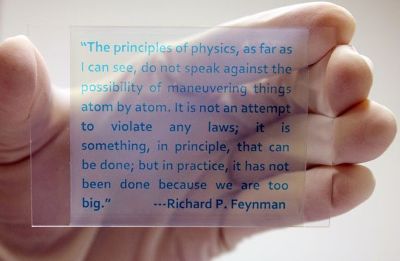Dec 4 2014
First developed in China in about the year A.D. 150, paper has many uses, the most common being for writing and printing upon. Indeed, the development and spread of civilization owes much to paper’s use as writing material.
 Yadong Yin's lab at the University of California, Riverside has fabricated novel rewritable paper, one that is based on the color switching property of commercial chemicals called redox dyes. Photo credit: Yin Lab, UC Riverside.
Yadong Yin's lab at the University of California, Riverside has fabricated novel rewritable paper, one that is based on the color switching property of commercial chemicals called redox dyes. Photo credit: Yin Lab, UC Riverside.
According to some surveys, 90 percent of all information in businesses today is retained on paper, even though the bulk of this printed paper is discarded after just one-time use.
Such waste of paper (and ink cartridges)—not to mention the accompanying environmental problems such as deforestation and chemical pollution to air, water and land—could be curtailed if the paper were “rewritable,” that is, capable of being written on and erased multiple times.
Chemists at the University of California, Riverside have now fabricated in the lab just such novel rewritable paper, one that is based on the color switching property of commercial chemicals called redox dyes. The dye forms the imaging layer of the paper. Printing is achieved by using ultraviolet light to photobleach the dye, except the portions that constitute the text on the paper. The new rewritable paper can be erased and written on more than 20 times with no significant loss in contrast or resolution.
“This rewritable paper does not require additional inks for printing, making it both economically and environmentally viable,” said Yadong Yin, a professor of chemistry, whose lab led the research. “It represents an attractive alternative to regular paper in meeting the increasing global needs for sustainability and environmental conservation.”
Study results appear online today (Dec. 2) in Nature Communications.
The rewritable paper is essentially rewritable media in the form of glass or plastic film to which letters and patterns can be repeatedly printed, retained for days, and then erased by simple heating.
The paper comes in three primary colors: blue, red and green, produced by using the commercial redox dyes methylene blue, neutral red and acid green, respectively. Included in the dye are titania nanocrystals (these serve as catalysts) and the thickening agent hydroxyethyl cellulose (HEC). The combination of the dye, catalysts and HEC lends high reversibility and repeatability to the film.
During the writing phase, ultraviolet light reduces the dye to its colorless state. During the erasing phase, re-oxidation of the reduced dye recovers the original color; that is, the imaging material recovers its original color by reacting with ambient oxygen. Heating at 115 C can speed up the reaction so that the erasing process is often completed in less than 10 minutes.
“The printed letters remain legible with high resolution at ambient conditions for more than three days – long enough for practical applications such as reading newspapers,” Yin said. “Better still, our rewritable paper is simple to make, has low production cost, low toxicity and low energy consumption.”
His lab is currently working on a paper version of the rewritable paper.
“Even for this kind of paper, heating to 115 C poses no problem,” Yin said. “In conventional laser printers, paper is already heated to 200 C in order to get toner particles to bond to the paper surface.”
His lab also is working on increasing the cycling number (the number of times the rewritable paper can be printed and erased), with a target of 100, to reduce overall cost. His research team is exploring ways to extend the legibility of the printed texts or images for more than three days to expand their potential uses.
“One way is to develop new photocatalyst nanoparticles that become highly reductive when irradiated by ultraviolet light,” Yin said. “We are exploring, too, the possibility of multi-color printing. The design principle can be extended to various commercial redox dyes to produce rewritable paper capable of showing prints of different colors. All these efforts will help increase the practical applications of the technology.”
He was joined in the study by UC Riverside’s Wenshou Wang (first author of the research paper), Ning Xie and Le He. Wang and Yin conceived and designed the experiments. Wang performed the experiments. Xie and He contributed to sample analysis. Wang and Yin analyzed the results.
Chemists at the University of California, Riverside fabricate novel rewritable paper
The research was funded by a grant to Yin from the U.S. Department of Energy.
This technology has been disclosed and assigned UC case number 2015-250. A provisional patent has been filed and the UCR Office of Technology Commercialization is actively seeking a company to license the technology.
Yin’s lab has recently synthesized a colloidal titania nanoparticle catalyst doped with barium ions that enables reversible light-responsive color switching with excellent cycling performance and considerably high switching rate.
“The improved performance is attributed to the more effective removal of the photogenerated oxidative holes that results from barium doping. This leaves more electrons for promoting the reduction of redox dyes,” Yin said.